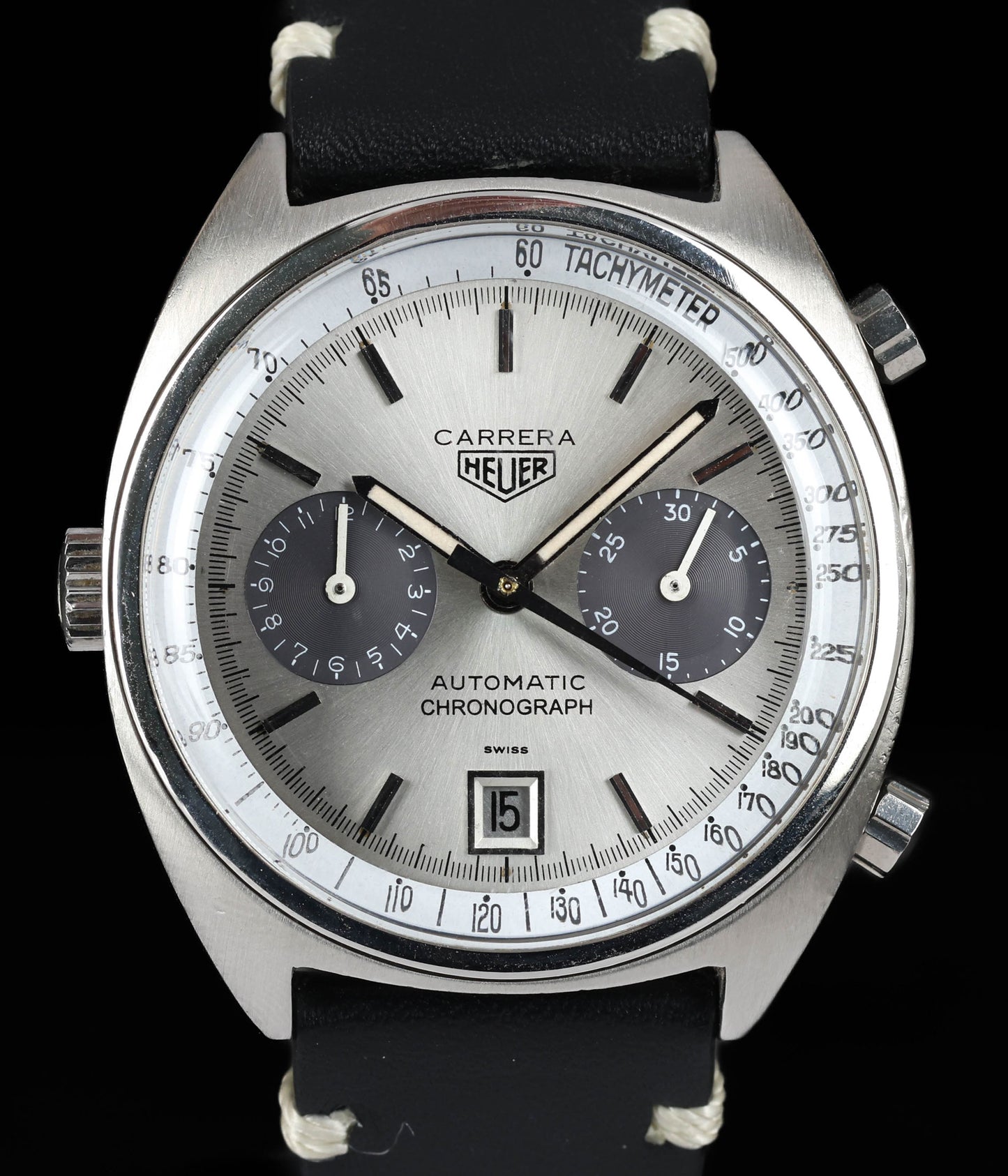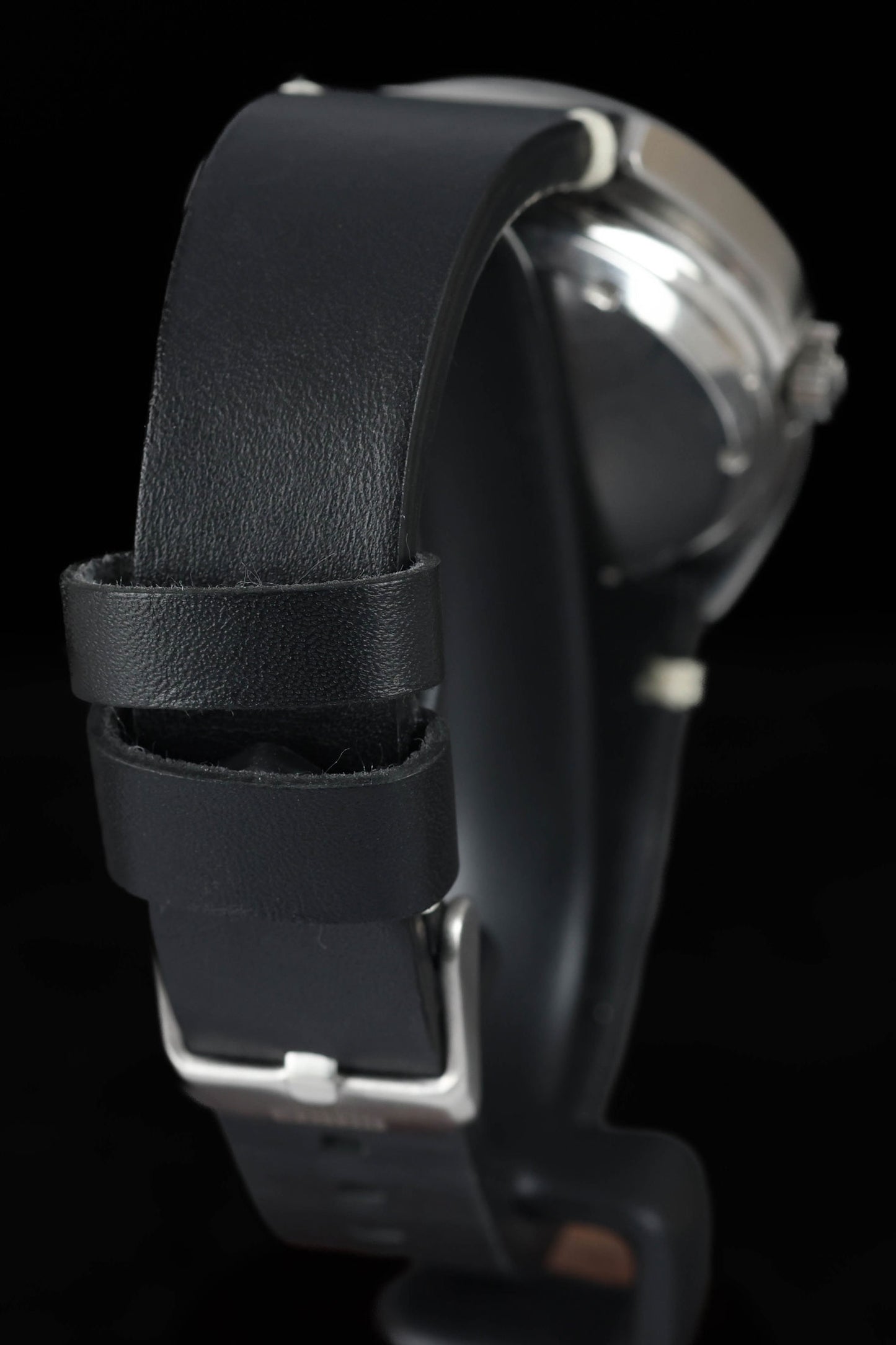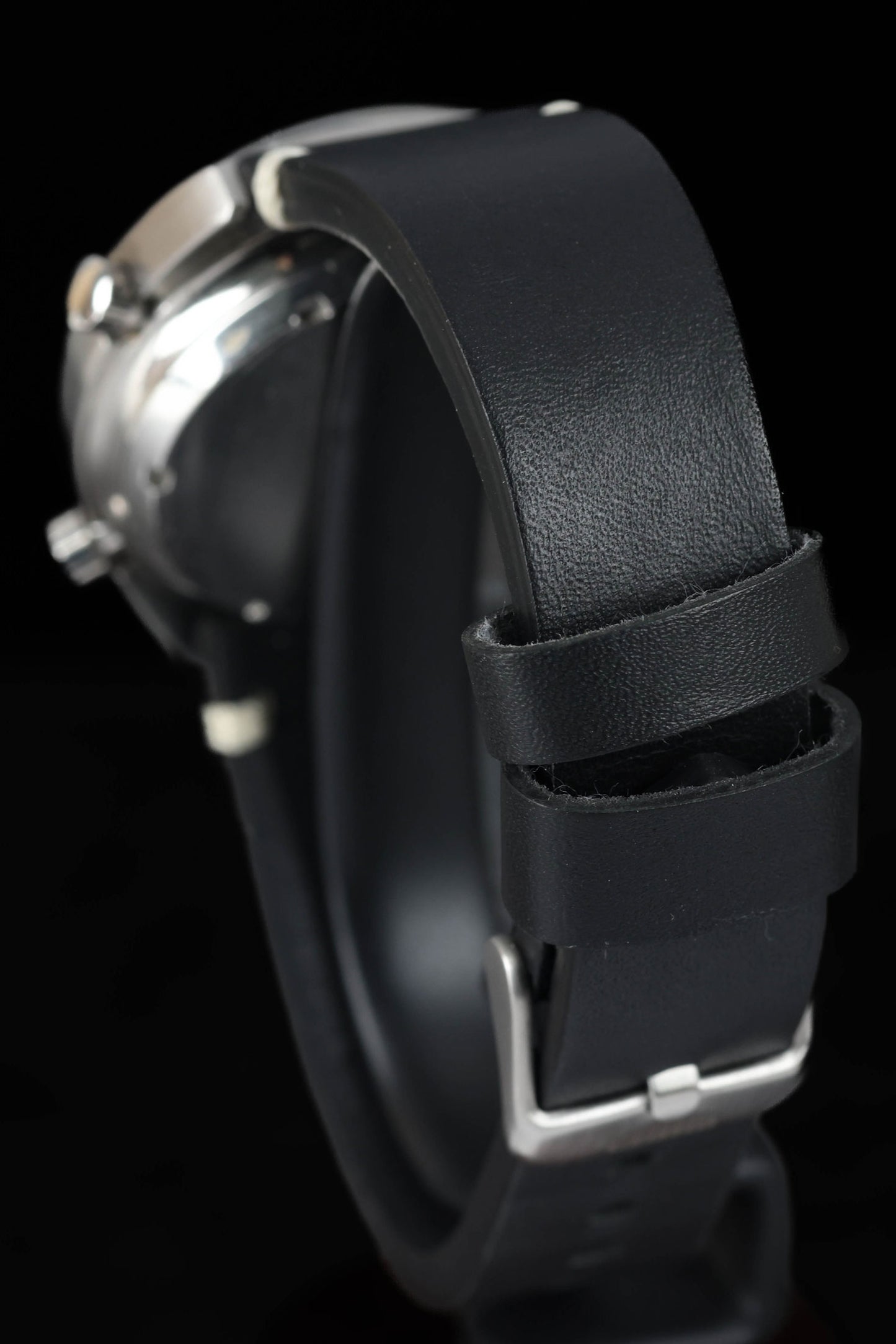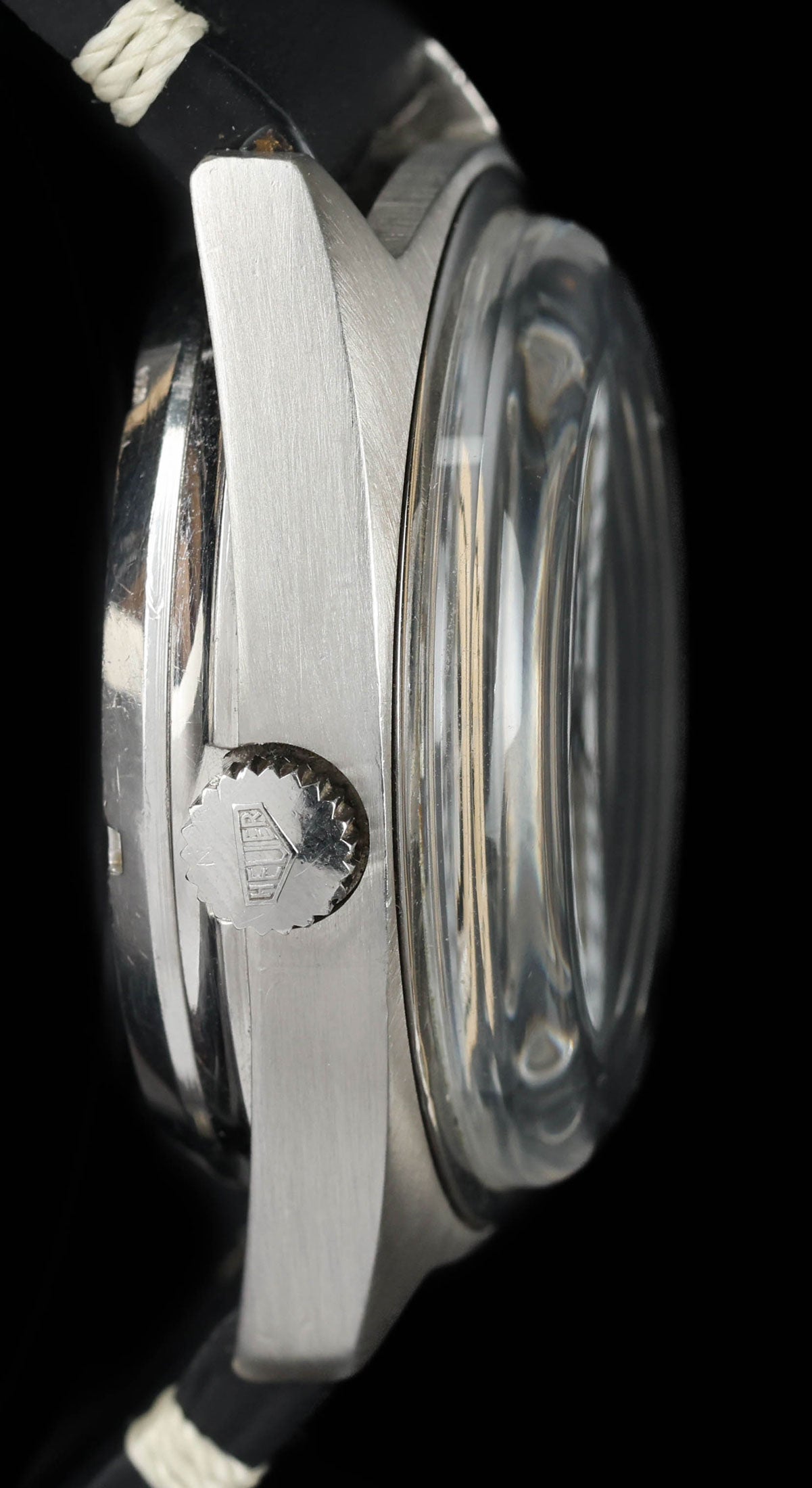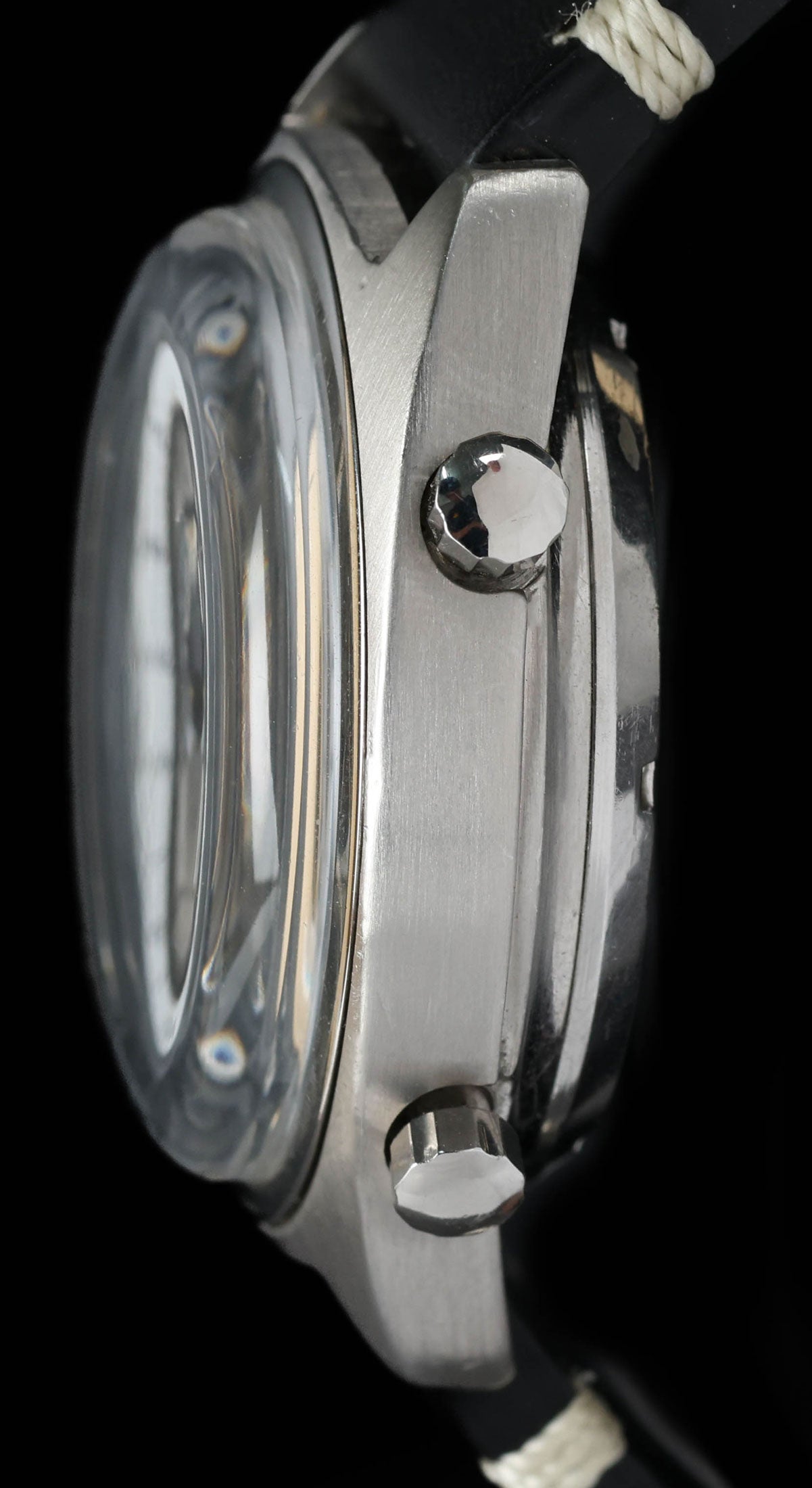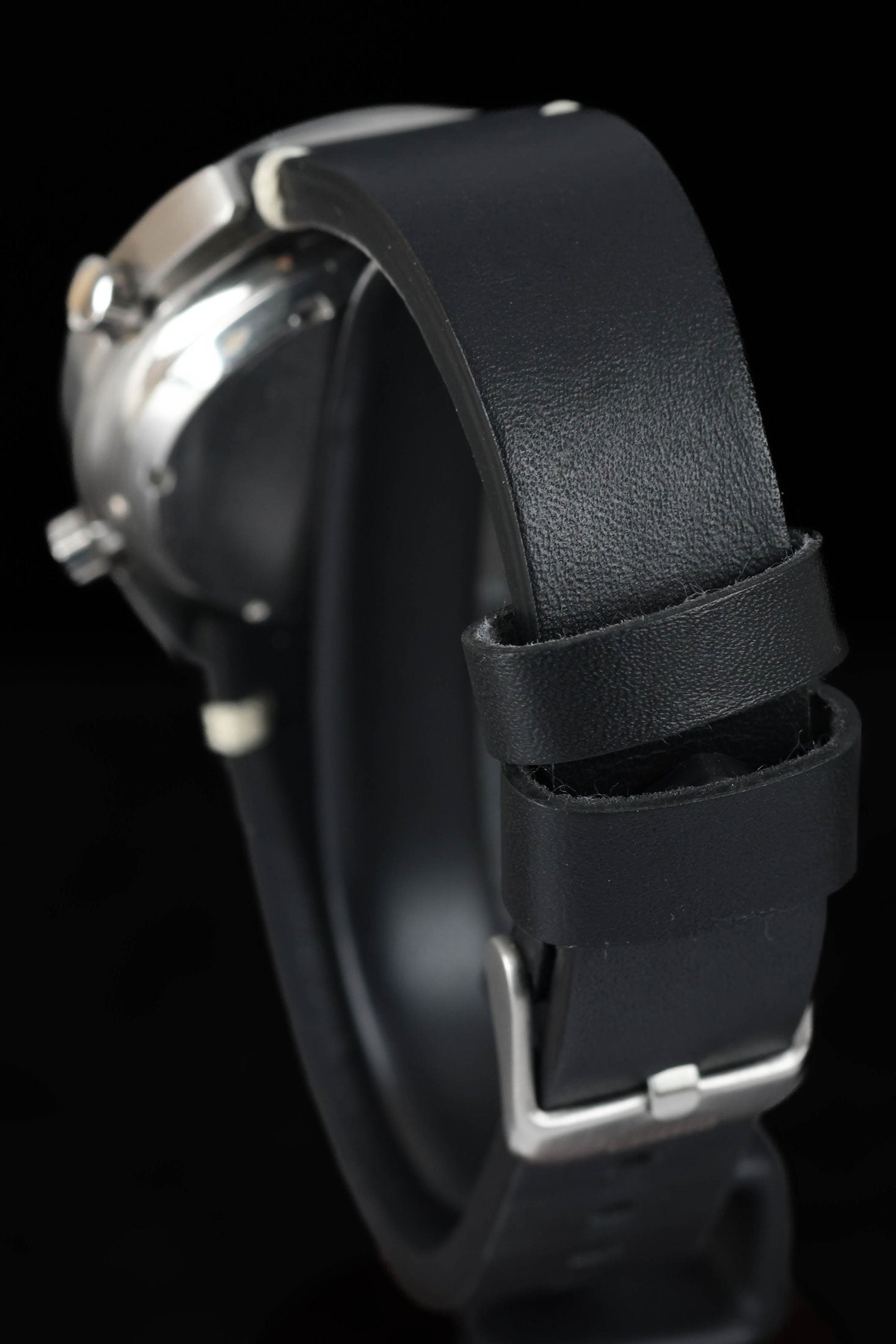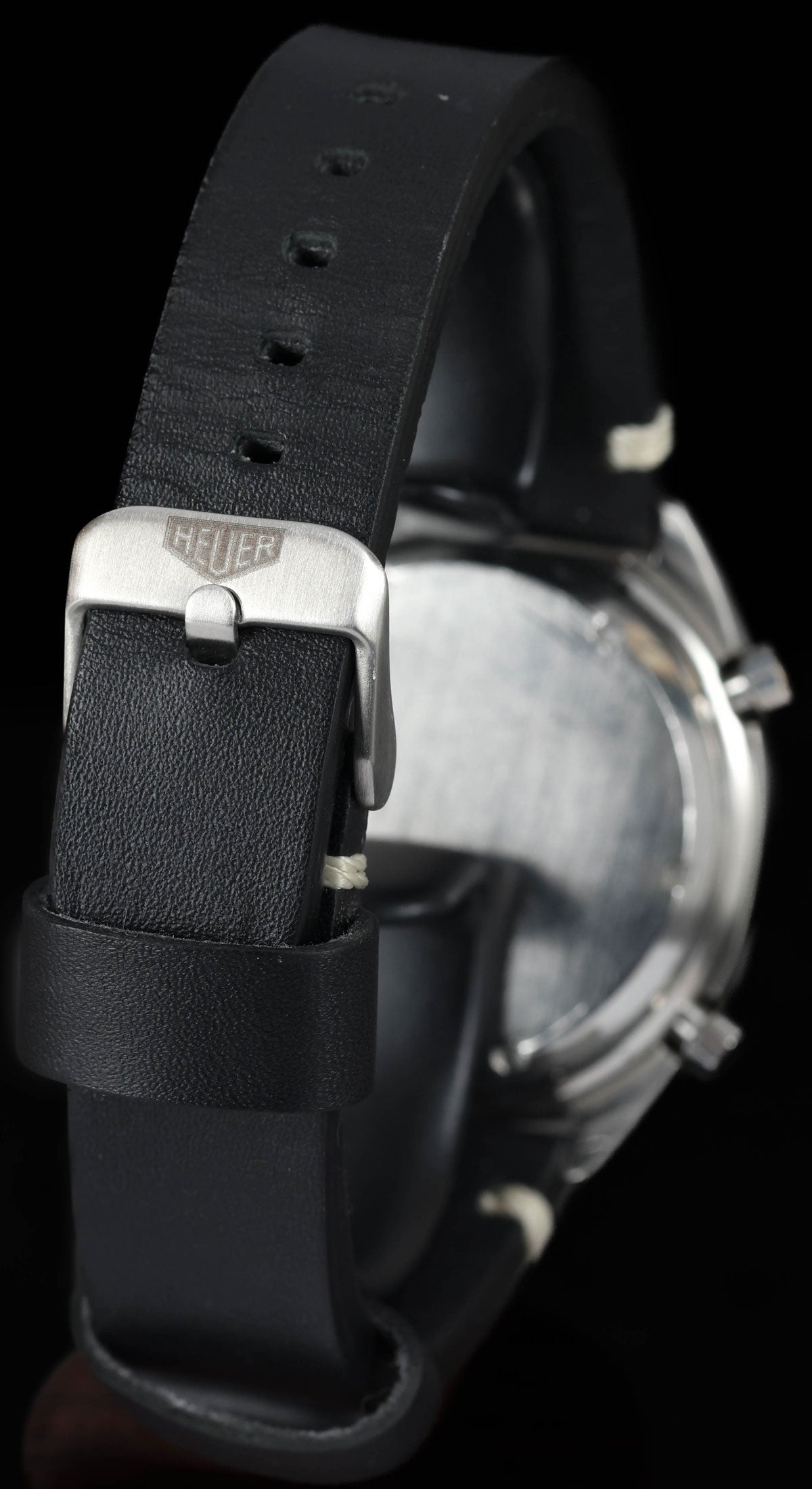Crown Vintage
Heuer Carrera 110.253G 38.5mm Circa 1977
Heuer Carrera 110.253G 38.5mm Circa 1977
Couldn't load pickup availability
The stainless steel case presents in good overall condition, with only light hairline scratches consistent with careful wear. It appears to remain unpolished, retaining its sharp edges and original finishing. The dial and hands show minor signs of oxidation, typical of a watch from this era, yet remain in good condition with clear legibility. Their luminous elements, though aged, are still present. The watch is currently fitted with an aftermarket leather strap in good condition, complemented by a Heuer-branded clasp. Overall, this example offers a well-preserved representation of the Heuer Carrera 110.253G.
Share
Why we love this watch
Why we love this watch
The Timeless Appeal of the Heuer Carrera 110.253G
Few watches capture the spirit of automotive racing and Swiss craftsmanship quite like the Heuer Carrera. This Heuer Carrera 110.253G with its luminous starburst dial from 1977 is a very special watch. Revered for its distinct design, this particular reference remains an emblem of Heuer’s commitment to watchmaking.
The Founding of Heuer
The Heuer story begins in 1860, when Edouard Heuer established his watchmaking workshop in St-Imier, Switzerland. With an innovative mindset and a relentless pursuit of accuracy, Heuer quickly gained a reputation for pioneering timekeeping instruments and mechanisms. One of the brand’s most significant early achievements was the invention of the oscillating pinion in 1887—an essential component that greatly simplified the production of chronographs. This development not only demonstrated Heuer’s penchant for technical progress, but it also laid the groundwork for the brand’s later dominance in the realm of sports timing.
Throughout the early 20th century, Heuer continued to refine its expertise in precision timekeeping, becoming the official timekeeper for major sporting events—particularly automotive races (as it is again in 2025). This focus on racing would eventually give rise to one of Heuer’s most illustrious collections: the Carrera.
The Racing Connection
For Heuer, the world of motor racing was an ideal proving ground for its chronograph technology. High-speed racing demanded split-second accuracy and robust build quality to endure intense vibrations, extreme temperatures, and high impacts. From Formula 1 to endurance racing, Heuer chronographs became indispensable instruments for drivers and pit crews alike.
In 1962, Jack Heuer (the great-grandson of Edouard Heuer) saw an opportunity to design a watch specifically tailored to racing professionals. Inspired by the high-octane excitement of motorsport, Jack Heuer set out to create a minimalist, legible, and reliable chronograph that would become an integral part of a driver’s toolkit. By 1963, this vision materialised in the form of the Heuer Carrera—a name that paid homage to the famed Carrera Panamericana race in Mexico, one of the most gruelling and dangerous events in motorsport history.
The Birth and Evolution of the Heuer Carrera
Defining Characteristics
The original Heuer Carrera of 1963 was ground-breaking for its clean, uncluttered dial. Minimalism was a priority, with clear markers and a simple layout that improved legibility for high-speed racing. The watch’s robust case design protected its movement from the harsh conditions of the track, while the sharp-edged lugs and slim bezel underscored its modern aesthetic.
Throughout the 1960s, the Carrera line grew in popularity, winning the hearts of professional drivers and watch enthusiasts alike. The success of the Carrera was further boosted by celebrity endorsements, including prominent racing legends. By the end of the decade, Heuer had carved out a reputation as a premier manufacturer of chronographs that could withstand the rigours of professional racing.
Technological Advancements
In the late 1960s and early 1970s, watchmakers around the world were engaged in a race of their own—the quest to develop the first automatic chronograph movement. Heuer, in collaboration with Breitling, Buren-Hamilton, and Dubois-Depraz, unveiled the Calibre 11 in 1969. This innovative movement was among the very first self-winding chronograph mechanisms, and Heuer promptly integrated it into the Carrera line.
Subsequent versions of this movement—such as the Calibre 12—offered improvements in reliability and performance. These advancements enabled Heuer to produce a new generation of Carrera watches that combined the convenience of an automatic movement with the brand’s hallmark accuracy and style. It was during this period of heightened innovation that the reference 110.253G emerged, featuring design elements quintessential to 1970s watchmaking.
The 1977 Heuer Carrera 110.253G
Design and Aesthetics
The Heuer Carrera's of the 1970s epitomise the bold stylistic choices that set the decade apart. Moving away from the comparatively understated aesthetics of the 1960s, the 1970s ushered in a more experimental era for watch design—characterised by larger cases, distinctive colour palettes, and unique dial textures.
One of the most striking aspects of the 110.253G is its luminous starburst dial, which captures and reflects light in an eye-catching manner. This unique finish gives the watch a dynamic quality, appearing to shift colour and sheen depending on the angle of the wrist. Luminous hour markers and hands further enhance legibility, ensuring that the chronograph remains easy to read even under low-light conditions.
The case itself retains the angular look that Heuer enthusiasts love, with pronounced lugs and a well-proportioned bezel. However, the 1970s influence is apparent in the watch’s slightly more robust dimensions, catering to a generation that favoured bolder wrist presence. Although vintage by today’s standards, the size of the 110.253G still feels contemporary enough to appeal to modern collectors and style-conscious watch fans.
Movement and Mechanicals
The Carrera 110.253G is powered by the automatic Calibre 12. This movement is a successor to the revolutionary Calibre 11 and carries forward many of its technical innovations. Key features of the Calibre 12 include:
1. Micro-rotor mechanism: A compact rotor system that allows for efficient winding without significantly increasing the overall thickness of the watch.
2. High beat rate: Operating at 21,600 vibrations per hour (3 Hz), providing accurate timekeeping and smooth chronograph operation.
3. Date display: A practical addition positioned to ensure minimal interference with the dial’s chronograph layout.
Designed for precision and durability, the Calibre 12 exemplifies Heuer’s commitment to performance. Although modern automatic chronograph movements have since become more refined, the Calibre 12 remains highly regarded for its role in pioneering automatic chronograph technology and is a fitting choice for a watch that celebrates the brand’s innovative roots.
Collectability and Rarity
Not all Heuer Carreras are created equal, and the 110.253G’s distinctive dial makes it particularly desirable among collectors. While the standard Carrera models of this era are already prized, the luminous starburst variant offers an extra layer of visual intrigue and uniqueness. Furthermore, the 1970s represented a tumultuous period for the Swiss watch industry, with the advent of quartz technology leading to decreased production numbers for mechanical watches. As a result, surviving examples of vintage Carrera references—especially those in good condition—are increasingly rare.
For prospective buyers, finding an unpolished or well-preserved 110.253G can be challenging, and prices on the vintage market often reflect this scarcity. Documented provenance, original parts, and the presence of accompanying box and papers can further increase the watch’s value.
Heuer Carrera’s Enduring Legacy
The Modern Influence
While many watch brands have a storied past, few can rival Heuer’s influence on the design and function of chronographs. The legacy of the Carrera, in particular, is profound. Modern TAG Heuer Carreras (TAG Heuer emerged when Techniques d’Avant Garde acquired Heuer in 1985) continue to reflect the clean lines, robust construction, and racing spirit that defined the original models.
Some contemporary interpretations pay direct homage to vintage references, including design cues such as retro-style hands and hour markers or heritage-inspired dial textures. These modern tributes serve as a reminder of the Carrera’s timeless design language and its inseparable links to the golden age of motorsport.
Collecting Vintage Carreras
For enthusiasts of vintage watches, the Heuer Carrera line is a compelling place to begin or expand a collection. With a wide range of designs, dial variations, and historical significance, it offers both aesthetic diversity and a fascinating link to motorsport heritage.
Conclusion
The Heuer Carrera symbolises Heuer’s pioneering role in developing innovative chronographs for the racing world and exemplifies the bold design aesthetics of its era. From the brand’s early origins in St-Imier to its status as a revered icon of motorsport timing, Heuer has remained at the forefront of watchmaking excellence.
By combining technological breakthroughs like the Calibre 12 with design flourishes that continue to capture the imagination of enthusiasts, the 110.253G has rightfully earned its place in the pantheon of collectible vintage watches. Today, its timeless appeal resonates with collectors who appreciate the fusion of form and function, as well as the enduring legacy of a watch that once graced the wrists of professional drivers and racing aficionados alike. For anyone seeking to own a slice of horological and motorsport history, the 1977 Heuer Carrera we have for sale proves itself to be a true time capsule of its era.
Case & Bracelet
Case & Bracelet
Case is in good condition with light hairline scratches. It appears to have not been polished. The band is an after market leather strap with a Heuer clasp and is in good condition
Dial & Hands
Dial & Hands
Dial and hands have signs of oxidation but are in good condition
Warranty & Condition
Warranty & Condition
Crown Vintage Watches provides a minimum 3-month mechanical warranty on pre-owned watches, from the date of purchase.
The warranty covers mechanical defects only.
The warranty does not cover damages such as scratches, finish, crystals, glass, straps (leather, fabric or rubber damage due to wear and tear), damage resulting from wear under conditions exceeding the watch manufacturer’s water resistance limitations, and damage due to physical and or accidental abuse.
Please note, water resistance is neither tested nor guaranteed.
Shipping and insurance costs for warranty returns to us must be covered by the customer. Returns must be shipped via traceable courier. Return shipment must be pre-paid and fully insured. Collect shipping will be refused. In case of loss or damages, the customer is liable.
Our Pledge
At Crown Vintage Watches, we stand by the authenticity of every product we sell. For added peace of mind, customers are welcome to have items independently authenticated at their own expense.
Condition
Due to the nature of vintage timepieces, all watches are sold as is. We will accurately describe the current condition and working order of all watches we sell to the best of our ability.
Shipping & Refund
Shipping & Refund
